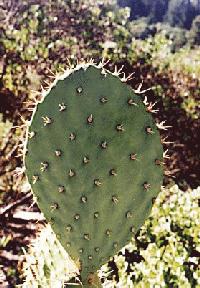XEROPHYTE LEAVES
Xerophytic leaves are modified to reduce water loss, often with a thick cuticle and sunken stomata because the plants live in dry conditions. The palisade layer is often more strongly developed than it is in mesophytes, with a reduced spongy layer because they often grow in places of high light intensity.
Cycas is in the Phylum Cycadophyta. These are gymnosperms from subtropical regions. They look a little bit like ferns. They have large leaves that are made up of small leaflets. When you examined the prepared slide in lab you were looking at a section through one leaflet.
Note the midvein; palisade mesophyll; spongy mesophyll; the thick cuticle; the deeply sunken stomata, with overarching subsidiary cells; and the layer of suberized cells (hypodermis) just below the epidermis.
This is a handmade cross-section through a leaflet which has been stained with toluidine blue.
This is a close-up of the stomatal crypt. Remember the guard cells of this organism are sunken to prevent water loss. The overarching structures are the subsidiary cells.
Nerium
This is a cross-section through the leaf of Nerium. This plant is native to the Mediterranean, but is a common ornamental plant around the world. Can you find four adaptations this plant exhibits to a xerophytic habitat?
Here is a close-up of “stomatal crypts”. They are found on the abaxial side of the leaf. They are pits in which the you find stomata.
Cacti
Other leaves are modified for a xerophytic environment by becoming drastically reduced and no longer having a photosynthetic function. They now serve a defense, in the form of spines, for the succulent photosynthetic stem. They are also believed to be important in the dissipation of heat by the plant.
MESOPHYTES (there is no shortage of available water)
XEROPHYTES (dry habitat)
HYDROPHYTES (lots of water)
TRICHOMES AND LEAF APPENDAGES
LEAF MODIFICATIONS
BACK TO LEAF FRONTPAGE








